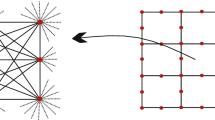Abstract
Various algorithms have been proposed for the determination of the optimum paths in line networks. Moving in space is a far more complex problem, where research has been scarce. An example would be the determination of the shortest sea course between two given ports. This paper presents an examination of the problem, states the weaknesses of the existing solutions, and introduces a new approach, which can be easily applied to a variety of spaces, while considering different travel cost models. The implementation of the algorithm for movements on the plane surface, in the three-dimensional space, and on the spherical surface as an approximation of the earth, has been examined. The results are illustrated through several examples.
Preview
Unable to display preview. Download preview PDF.
Similar content being viewed by others
References
S. Aronoff: ‘Geographic Information Systems: A Management Perspective', WDL Publications, Ottawa, Canada, 1989.
E.W. Dijkstra: ‘A Note on Two Problems in Connection Graphs', Numerische Mathematik, No.1, 269–271, 1959.
D.H. Douglas: ‘A Solution to the Least Cost Path Problem in GIS', Proceedings of the Canadian Conference on GIS, Ottawa, Canada, 1083–1089, 1994.
D.H. Douglas: ‘The Parsimonious Path Based on the Implicit Geometry in Gridded Data and on a Proper Slope Line Generated from It', Proceedings of the International Symposium on Spatial Data Handling, Edinburgh, Scotland, 1133–1140, 1994.
G. Dutton: ‘Geodesic Modeling of Planetary Relief', Cartographica, Vol.21, No.2, 3, 188–207, 1984.
G. Dutton: ‘Modeling Locational Uncertainty via Hierarchical Tessellation', in ‘Accuracy of Spatial Databases', Edited by M. Goodchild and S. Gopal, Taylor-Francis Ltd, 125–140, 1989.
G.N. Frederickson: ‘Fast Algorithms for Shortest Paths in Planar Graphs, with Applications', SLAM Journal on Computing, Vol.16, No.6, 1004–1022, 1987.
A. Gibbons: ‘Algorithmic Graph Theory', Cambridge University Press Ltd, 1985.
M.F. Goodchild, Y. Shiren: ‘A Hierarchical Spatial Data Structure for Global Geographic Information Systems', Proceedings of the International Symposium on Spatial Data Handling, Zurich, Switzerland, 911–917, 1990.
M.F. Goodchild, Y. Shiren, G. Dutton: 'spatial Data Representation and Basic Operations for a Triangular Data Structure', National Center for Geographic Information and Analysis, Report 91-8, 33 pp, 1991.
M.F. Goodchild, Y. Shiren: ‘A Hierarchical Spatial Data Structure for Global Geographic Information Systems', Graphical Models and Image Processing, Vol.54, No.1, 31–44, 1992.
S.K. Jensen: ‘Automated Derivation of Hydrologic Basin Characteristics from Digital Elevation Model Data', Proceedings of the Auto-Carto 7, Digital Representation of Spatial Knowledge, 1985.
D.B. Johnson: ‘Efficient Algorithms for Shortest Paths in Sparse Networks', Journal of the Association of Computing Machinery, Vol.24, No.1, 1–13, 1977.
R. Laurini, D. Thompson: ‘Fundamentals of Spatial Information Systems', Academic Press Ltd, 1992.
E.S. Lindgren: ‘Proposed Solution for the Minimum Path Problem', Harvard Papers in Theoretical Geography, Geography and the Properties of Surfaces Series, Cambridge, No.4, 23 pp, 1967.
E.S. Lindgren: ‘A Minimum Path Problem Reconsidered', Harvard Papers in Theoretical Geography, Geography and the Properties of Surfaces Series, Cambridge, No.28, 11 pp, 1969.
E.S. Lindgren: ‘A Study of the Movement of a Point on a Plane and in Space', Harvard Papers in Theoretical Geography, Geography and the Properties of Surfaces Series, Cambridge, No.36, 16 pp, 1969.
R. Sedgewick: ‘Algorithms', Addison-Wesley Publishing Company, Inc, 1990.
C.D. Tomlin: ‘Geographic Information Systems and Cartographic Modeling', Prentice Hall, Englewood Cliffs, N.J., 1990.
W. Warntz: ‘Transportation, Social Physics, and the Law of Refraction', The Professional Geographer, Vol.9, No.4, 2–7, 1957.
W. Warntz: ‘Transatlantic Flights and Pressure Patterns', The Geographical Review, Vol.51, 187–212, 1961.
Author information
Authors and Affiliations
Editor information
Rights and permissions
Copyright information
© 1995 Springer-Verlag Berlin Heidelberg
About this paper
Cite this paper
Stefanakis, E., Kavouras, M. (1995). On the determination of the optimum path in space. In: Frank, A.U., Kuhn, W. (eds) Spatial Information Theory A Theoretical Basis for GIS. COSIT 1995. Lecture Notes in Computer Science, vol 988. Springer, Berlin, Heidelberg. https://doi.org/10.1007/3-540-60392-1_16
Download citation
DOI: https://doi.org/10.1007/3-540-60392-1_16
Published:
Publisher Name: Springer, Berlin, Heidelberg
Print ISBN: 978-3-540-60392-4
Online ISBN: 978-3-540-45519-6
eBook Packages: Springer Book Archive




